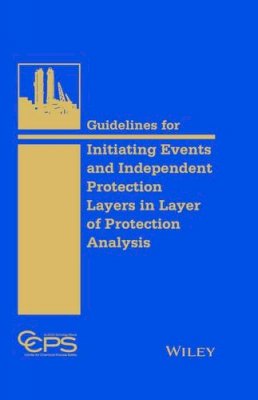
Stock image for illustration purposes only - book cover, edition or condition may vary.
Guidelines for Independent Protection Layers and Initiating Events
Ccps (Center For Chemical Process Safety)
€ 113.72
FREE Delivery in Ireland
Description for Guidelines for Independent Protection Layers and Initiating Events
Hardcover. The publication provides process automation engineers, process engineers, facility operators, and safety professionals with the appropriate treatment and requirements applicable to equipment design, administrative procedures, or other credits that are treated as an independent protection layer from a Layer of Protection Analysis (LOPA) perspective. Num Pages: 384 pages. BIC Classification: KNDC; KNXC. Category: (P) Professional & Vocational. Dimension: 244 x 157 x 24. Weight in Grams: 674.
The book is a guide for Layers of Protection Analysis (LOPA) practitioners. It explains the onion skin model and in particular, how it relates to the use of LOPA and the need for non-safety instrumented independent protection layers. It provides specific guidance on Independent Protection Layers (IPLs) that are not Safety Instrumented Systems (SIS). Using the LOPA methodology, companies typically take credit for risk reductions accomplished through non-SIS alternatives; i.e. administrative procedures, equipment design, etc. It addresses issues such as how to ensure the effectiveness and maintain reliability for administrative controls or “inherently safer, passive” concepts.
This book will address how the fields of Human Reliability Analysis, Fault Tree Analysis, Inherent Safety, Audits and Assessments, Maintenance, and Emergency Response relate to LOPA and SIS.
The book will separate IPL’s into categories such as the following:
- Inherent Safety
- eliminates a scenario or fundamentally reduces a hazard
- Preventive/Proactive
- prevents initiating event from occurring such as enhanced maintenance
- Preventive/Active
- stops chain of events after initiating event occurs but before an incident has occurred such as high level in a tank shutting off the pump.
- Mitigation (active or passive)
- minimizes impact once an incident has occurred such as closing block valves once LEL is detected in the dike (active) or the dike preventing contamination of groundwater (passive).
Product Details
Publisher
John Wiley and Sons Ltd United Kingdom
Number of pages
150
Format
Hardback
Publication date
2014
Condition
New
Weight
657 g
Number of Pages
384
Place of Publication
, United States
ISBN
9780470343852
SKU
V9780470343852
Shipping Time
Usually ships in 4 to 8 working days
Ref
99-2
About Ccps (Center For Chemical Process Safety)
Since 1985, the Center for Chemical Process Safety (CCPS) has been the world leader in developing and disseminating information on process safety management and technology. CCPS, an industry technology alliance of the American Institute of Chemical Engineers (AIChE), has published over 80 books in its process safety guidelines and process safety concepts series, and over 100 training modules through its Safety in Chemical Engineering Education (SACHE) series.
Reviews for Guidelines for Independent Protection Layers and Initiating Events
